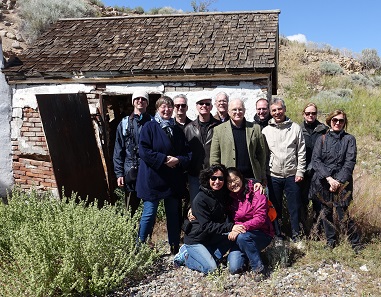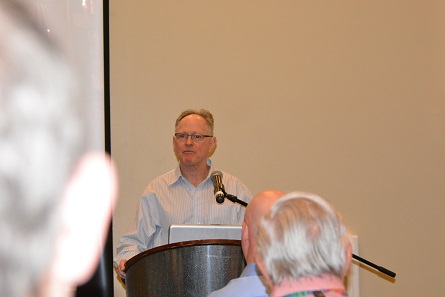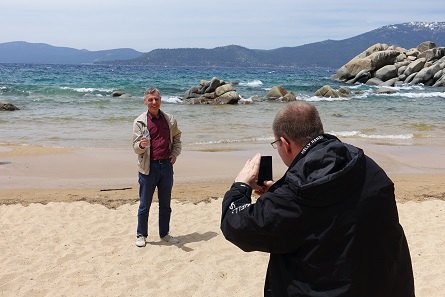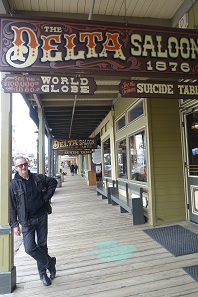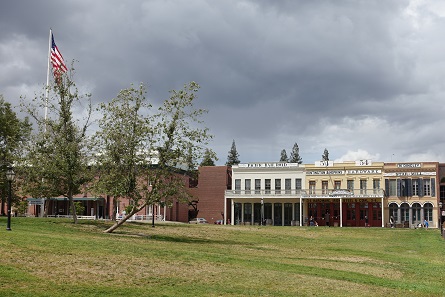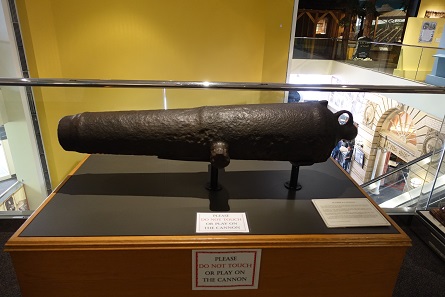by Ursula Kampmann
translated by Annika Backe
June 9, 2016 – DAMIN stands for Dépréciation de l’Argent Monétaire et relations INternationales, which translates as Depreciation of Silver: Monetary and International Relations. After all, it is clear to see that in the 19th century, the exponential growth of silver yielded from the mines of the New World had a radical impact on the monetary system of the Old World. In 1816, Great Britain adopted the gold standard, followed up by Australia and Canada in 1852 and 1853, as well as Germany in 1871, and so on: One country after another abolished its traditional silver, in order to find shelter in the safety of a golden harbor.
The DAMIN team during the post congress tour to Virginia City. Photograph: Saul Guerrero.
Supervised by Georges Depeyrot, the project also publishes the records of mints from all around the world. Already in the 19th century, there was a global economy, and changes taking place in one country did affect other nations as well. The possible extent of this is illustrated by the Comstock Lode. This was the site visited by the attendees of the final Round Table of the DAMIN project during their post congress tour.
Saul Guerrero elaborated on the importance and, most of all, the costs of mercury when used for the amalgamation process. Photograph: UK.
But the pleasure was preceded by the work, to be more specific, by five working sessions comprising 13 lectures at the University of the Pacific, first in San Francisco, then in Stockton. One focal point was the silver mines in the New World and their exploitation through the amalgamation process.
What did it mean, for example, when mercury was found in the New Almaden Mine in California in 1845? Very simple: The miners of the Old World knew silver ore mainly in connection with lead or copper, that could easily be melted out by using fire. In the New World, on the other hand, it occurred in conjunction with sulfide. Even though it was possible to smelt it, as was usual in Europe, the quantities in which it was found it made it highly expensive to supply the necessary fuel. Another option was to apply the amalgamation process, by means of mercury. Although requiring significantly less wood, the latter was based on the purchase of expensive mercury. When the price of mercury halved in 1776, the amalgamation process prevailed.
David St. Clair painted an impressive picture of how the Rothschild dynasty tried to monopolize mercury which, however, was rendered obsolete with the discovery of the New Almaden Mine.
Of course, there were more insights into the Californian conditions to come. Gray Brechin talked about the financial impact of the Comstock Lode on U.S. American politics. The wealth of silver helped funding the American Civil War, building the transcontinental railway, and laying the transoceanic cable.
Dennis Flynn, University of the Pacific, organized the congress. Photograph: Georges Depeyrot.
The speakers did not restrict themselves to California alone. Jin CAO addressed mining in the Wild West of China. Simon Bytheway focused on Australia, Peter Hilsenrath and Thomas Pogue on South Africa, and Claudia de Lozanne Jefferies on Mexico. Others looked at countries that did not have any mines containing precious metal themselves and thus had to draw back on expensive gold and silver imports. Michael Märcher highlighted the reasons why Danish Mint were rather reluctant to implement a much more effective assaying technique, while Ivar Leimus asked himself how Livonia managed to make its minting profitable. And Ursula Kampmann wanted to know why, of all coins, the Vienna Philharmonic turned out one of the world’s most popular bullion coins.
Michael Märcher takes a photo of his Livonian colleague Ivar Leimus. Photograph: UK.
The congress had taken place in San Francisco and Stockton. The destination of the post congress tour was Lake Tahoe …
Georges Depeyrot in the touristy ghost town of Virginia City. Photograph: UK.
… as well as Virginia City, which was founded on top and as a result of the Comstock Lode.
Today, Sacramento has one of the few original architectural ensembles of the U.S. dating from the 1850s and 1860s. Photograph: UK.
The tour of the congress attendees was concluded by a trip to Sacramento, a settlement of gold diggers from the era of the Gold Rush, …
Canon from Sutter’s Fort. Photograph: UK.
… that evolved where the Swiss Johann August Sutter had founded New Helvetia.
The volumes of this congress will be published in the summer of 2016.
Additionally, all presentations were recorded on video. Also in the summer of 2016, these videos will also be uploaded onto the internet where they can then be watched by everybody free of charge.
If you want to learn more about the Comstock Lode, please make sure not to miss our article of the week.
Here you can find more information on the DAMIN congress.
The congress volumes of the 2015 Copenhagen Round Table revolving around mints, technology, and coin production can be ordered on the MONETA website.
And here you find all videos of the Copenhagen Round Table. Once the San Francisco videos will be available as well, we will notify you.





